U.S. Department of Transportation
Federal Highway Administration
1200 New Jersey Avenue, SE
Washington, DC 20590
202-366-4000
Federal Highway Administration Research and Technology
Coordinating, Developing, and Delivering Highway Transportation Innovations
 |
| This report is an archived publication and may contain dated technical, contact, and link information |
|
Publication Number: FHWA-RD-03-060 |
Previous | Table of Contents | Next
Table A-1. Mixture experiment design in terms of volume fractions of components
| Standard Order | Design ID | Run Order | A Water | B Cement | C Silica Fume | D HRWRA | E Coarse Agg | F Fine Agg |
|---|---|---|---|---|---|---|---|---|
| 35 | 127 | 1 | 0.1720 | 0.1395 | 0.0130 | 0.0060 | 0.4098 | 0.2598 |
| 7 | 15 | 2 | 0.1656 | 0.1500 | 0.0270 | 0.0074 | 0.4000 | 0.2500 |
| 14 | 38 | 3 | 0.1767 | 0.1417 | 0.0270 | 0.0046 | 0.4000 | 0.2500 |
| 11 | 22 | 4 | 0.1850 | 0.1474 | 0.0130 | 0.0046 | 0.4000 | 0.2500 |
| 22 | 71 | 5 | 0.1600 | 0.1500 | 0.0130 | 0.0074 | 0.4098 | 0.2598 |
| 4 | 11 | 6 | 0.1850 | 0.1300 | 0.0130 | 0.0046 | 0.4174 | 0.2500 |
| 2 | 5 | 7 | 0.1600 | 0.1300 | 0.0270 | 0.0046 | 0.4284 | 0.2500 |
| 8 | 16 | 8 | 0.1600 | 0.1300 | 0.0130 | 0.0046 | 0.4424 | 0.2500 |
| 27 | 91 | 9 | 0.1850 | 0.1300 | 0.0130 | 0.0074 | 0.4073 | 0.2573 |
| 29 | 101 | 10 | 0.1712 | 0.1500 | 0.0130 | 0.0046 | 0.4112 | 0.2500 |
| 24 | 78 | 11 | 0.1850 | 0.1300 | 0.0270 | 0.0074 | 0.4003 | 0.2503 |
| 37 | 127 | 12 | 0.1720 | 0.1395 | 0.0130 | 0.0060 | 0.4098 | 0.2598 |
| 9 | 20 | 13 | 0.1850 | 0.1300 | 0.0130 | 0.0046 | 0.4000 | 0.2674 |
| 30 | 103 | 14 | 0.1600 | 0.1500 | 0.0130 | 0.0060 | 0.4210 | 0.2500 |
| 5 | 13 | 15 | 0.1600 | 0.1300 | 0.0130 | 0.0046 | 0.4000 | 0.2924 |
| 12 | 28 | 16 | 0.1600 | 0.1300 | 0.0270 | 0.0046 | 0.4000 | 0.2784 |
| 28 | 98 | 17 | 0.1600 | 0.1400 | 0.0130 | 0.0046 | 0.4324 | 0.2500 |
| 36 | 127 | 18 | 0.1720 | 0.1395 | 0.0130 | 0.0060 | 0.4098 | 0.2598 |
| 26 | 89 | 19 | 0.1600 | 0.1400 | 0.0130 | 0.0046 | 0.4000 | 0.2824 |
| 39 | 163 | 20 | 0.1656 | 0.1343 | 0.0165 | 0.0067 | 0.4234 | 0.2536 |
| 31 | 110 | 21 | 0.1712 | 0.1500 | 0.0130 | 0.0046 | 0.4000 | 0.2612 |
| 1 | 5 | 22 | 0.1600 | 0.1300 | 0.0270 | 0.0046 | 0.4284 | 0.2500 |
| 3 | 11 | 23 | 0.1850 | 0.1300 | 0.0130 | 0.0046 | 0.4174 | 0.2500 |
| 25 | 87 | 24 | 0.1600 | 0.1300 | 0.0130 | 0.0046 | 0.4212 | 0.2712 |
| 20 | 66 | 25 | 0.1600 | 0.1300 | 0.0270 | 0.0074 | 0.4128 | 0.2628 |
| 16 | 38 | 26 | 0.1767 | 0.1417 | 0.0270 | 0.0046 | 0.4000 | 0.2500 |
| 18 | 63 | 27 | 0.1725 | 0.1300 | 0.0270 | 0.0074 | 0.4131 | 0.2500 |
| 17 | 48 | 28 | 0.1725 | 0.1300 | 0.0130 | 0.0074 | 0.4000 | 0.2771 |
| 21 | 70 | 29 | 0.1600 | 0.1500 | 0.0130 | 0.0060 | 0.4000 | 0.2710 |
| 13 | 37 | 30 | 0.1600 | 0.1400 | 0.0270 | 0.0074 | 0.4000 | 0.2656 |
| 19 | 65 | 31 | 0.1600 | 0.1400 | 0.0270 | 0.0074 | 0.4156 | 0.2500 |
| 38 | 127 | 32 | 0.1720 | 0.1395 | 0.0130 | 0.0060 | 0.4098 | 0.2598 |
| 32 | 116 | 33 | 0.1725 | 0.1300 | 0.0270 | 0.0074 | 0.4000 | 0.2631 |
| 10 | 20 | 34 | 0.1850 | 0.1300 | 0.0130 | 0.0046 | 0.4000 | 0.2674 |
| 23 | 71 | 35 | 0.1600 | 0.1500 | 0.0130 | 0.0074 | 0.4098 | 0.2598 |
| 33 | 123 | 36 | 0.1600 | 0.1400 | 0.0200 | 0.0060 | 0.4120 | 0.2620 |
| 34 | 127 | 37 | 0.1720 | 0.1395 | 0.0130 | 0.0060 | 0.4098 | 0.2598 |
| 6 | 15 | 38 | 0.1656 | 0.1500 | 0.0270 | 0.0074 | 0.4000 | 0.2500 |
| 15 | 38 | 39 | 0.1767 | 0.1417 | 0.0270 | 0.0046 | 0.4000 | 0.2500 |
Table A-2. Mixture experiment: slump and 1-day strength data
| Obs | Design ID | Run Order | Slump (mm) | 1-Day Strength (MPa) | ||||
|---|---|---|---|---|---|---|---|---|
| 32 | 127 | 1 | 50.8 | 54.0 | 24.3 | 24.4 | 24.0 | - |
| 6 | 15 | 2 | 25.4 | 31.8 | 24.6 | 22.9 | 25.9 | - |
| 13 | 38 | 3 | 19.1 | 19.1 | 22.7 | 22.6 | 22.1 | - |
| 10 | 22 | 4 | 69.9 | 63.5 | 21.1 | 21.4 | 21.8 | - |
| 20 | 71 | 5 | 63.5 | 50.8 | 26.9 | 27.2 | 26.5 | 27.5 |
| 3 | 11 | 6 | 108.0 | 95.3 | 16.7 | 16.6 | 17.0 | - |
| 1 | 5 | 7 | 12.7 | 12.7 | 21.7 | 23.3 | 22.2 | - |
| 7 | 16 | 8 | 38.1 | 31.8 | 21.8 | 21.6 | 21.4 | - |
| 25 | 91 | 9 | 203.2 | 196.9 | 17.1 | 16.6 | 16.7 | - |
| 27 | 101 | 10 | 25.4 | 19.1 | 26.4 | 26.5 | 26.8 | - |
| 22 | 78 | 11 | 127.0 | 127.0 | 19.2 | 19.3 | 19.0 | - |
| 33 | 127 | 12 | 101.6 | 95.3 | 20.8 | 21.9 | 21.9 | - |
| 8 | 20 | 13 | 114.3 | 120.7 | 18.3 | 18.0 | 18.3 | - |
| 28 | 103 | 14 | 63.5 | 63.5 | 28.0 | 26.8 | 27.3 | - |
| 5 | 13 | 15 | 63.5 | 50.8 | 22.7 | 21.7 | 21.0 | - |
| 11 | 28 | 16 | 31.8 | 25.4 | 21.1 | 22.9 | 22.5 | - |
| 26 | 98 | 17 | 31.8 | 31.8 | 25.2 | 26.4 | 24.2 | - |
| 34 | 127 | 18 | 95.3 | 88.9 | 21.5 | 21.6 | 23.8 | - |
| 24 | 89 | 19 | 38.1 | 38.1 | 18.1 | 23.1 | 24.0 | - |
| 36 | 163 | 20 | 95.3 | 95.3 | 22.1 | 21.6 | 22.4 | - |
| 29 | 110 | 21 | 50.8 | 50.8 | 24.5 | 25.1 | 24.4 | - |
| 2 | 5 | 22 | 25.4 | 25.4 | 22.1 | 24.0 | 24.2 | - |
| 4 | 11 | 23 | 114.3 | 114.3 | 17.1 | 16.5 | 15.9 | - |
| 23 | 87 | 24 | 63.5 | 69.9 | 24.9 | 20.6 | 23.2 | - |
| 18 | 66 | 25 | 76.2 | 76.2 | 25.0 | 24.1 | 25.1 | - |
| 14 | 38 | 26 | 31.8 | 25.4 | 22.9 | 23.6 | 22.5 | - |
| 16 | 63 | 27 | 101.6 | 95.3 | 21.6 | 22.0 | 21.4 | - |
| 15 | 48 | 28 | 177.8 | 165.1 | 22.7 | 22.7 | 23.7 | - |
| 19 | 70 | 29 | 50.8 | 50.8 | 27.5 | 27.3 | 27.6 | - |
| 12 | 37 | 30 | 38.1 | 31.8 | 26.8 | 27.8 | 27.4 | - |
| 17 | 65 | 31 | 31.8 | 31.8 | 28.6 | 25.5 | 27.6 | - |
| 35 | 127 | 32 | 120.7 | 120.7 | 22.9 | 22.2 | 22.1 | - |
| 30 | 116 | 33 | 114.3 | 114.3 | 23.9 | 23.7 | 24.1 | - |
| 9 | 20 | 34 | 127.0 | 127.0 | 18.8 | 18.6 | 18.5 | - |
| 21 | 71 | 35 | 114.3 | 101.6 | 29.5 | 28.0 | 28.9 | - |
| 31 | 123 | 36 | 76.2 | 69.9 | 26.2 | 26.4 | 27.3 | - |
| 32 | 127 | 37 | 101.6 | 101.6 | 23.9 | 24.3 | 24.2 | - |
| 6 | 15 | 38 | 50.8 | 50.8 | 29.2 | 27.6 | 29.5 | - |
| 13 | 38 | 39 | 25.4 | 25.4 | 23.3 | 25.4 | 22.2 | - |
Table A-3. Mixture experiment: 28-day strength and RCT charge passed data
| Obs | Design ID | Run Order | 28-Day Strength (psi) | RCT Charge Passed (coulombs) | |||||
|---|---|---|---|---|---|---|---|---|---|
| 32 | 127 | 1 | 51.0 | 52.5 | 54.9 | - | - | - | - |
| 6 | 15 | 2 | 59.4 | 58.7 | 59.5 | - | - | - | - |
| 13 | 38 | 3 | 50.8 | 50.1 | 52.7 | - | - | - | - |
| 10 | 22 | 4 | 47.9 | 48.0 | 48.8 | - | 1203 | 1310 | 1321 |
| 20 | 71 | 5 | 51.9 | 56.7 | 57.0 | - | 901 | 790 | 894 |
| 3 | 11 | 6 | 47.3 | 51.7 | 46.6 | - | 1141 | 1308 | 1038 |
| 1 | 5 | 7 | 46.1 | 49.4 | 49.9 | - | 422 | 352 | - |
| 7 | 16 | 8 | 54.6 | 53.2 | 51.5 | - | 708 | - | 843 |
| 25 | 91 | 9 | 58.8 | 60.4 | 62.1 | - | 1092 | 1113 | 877 |
| 27 | 101 | 10 | 57.0 | 52.3 | 51.6 | - | 730 | 736 | 767 |
| 22 | 78 | 11 | 51.0 | 55.4 | 48.6 | - | 474 | 454 | 549 |
| 33 | 127 | 12 | 51.1 | 52.3 | 47.4 | - | 853 | 885 | 789 |
| 8 | 20 | 13 | 51.9 | 50.2 | 50.7 | - | 995 | 922 | 793 |
| 28 | 103 | 14 | 60.4 | 56.6 | 46.2 | 55.1 | 607 | 576 | 565 |
| 5 | 13 | 15 | 51.0 | 55.6 | 52.8 | - | 575 | 719 | 758 |
| 11 | 28 | 16 | 56.5 | 50.8 | 53.4 | - | 327 | 268 | 282 |
| 26 | 98 | 17 | 55.5 | 50.5 | 49.8 | - | 580 | 579 | 653 |
| 34 | 127 | 18 | 53.7 | 54.2 | 54.3 | - | 841 | 852 | 848 |
| 24 | 89 | 19 | 52.6 | 58.3 | 50.2 | 56.3 | 677 | 656 | 826 |
| 36 | 163 | 20 | 61.1 | 61.0 | 60.2 | - | 544 | 552 | 566 |
| 29 | 110 | 21 | 52.3 | 52.9 | 54.4 | - | 716 | 804 | 857 |
| 2 | 5 | 22 | 56.3 | 52.0 | 53.9 | - | 308 | 441 | 296 |
| 4 | 11 | 23 | 49.2 | 47.8 | 46.9 | - | 894 | 1054 | 956 |
| 23 | 87 | 24 | 53.0 | 50.4 | 49.4 | - | 751 | 618 | 732 |
| 18 | 66 | 25 | 57.1 | 62.6 | 59.7 | - | 326 | 319 | 303 |
| 14 | 38 | 26 | 57.4 | 51.8 | 50.3 | - | 450 | 346 | 375 |
| 16 | 63 | 27 | 56.6 | 54.5 | 54.5 | - | 324 | 324 | 257 |
| 15 | 48 | 28 | 58.9 | 58.0 | 57.3 | - | 622 | 702 | 723 |
| 19 | 70 | 29 | 54.7 | 52.5 | 56.4 | - | 496 | 494 | 524 |
| 12 | 37 | 30 | 49.2 | 57.8 | 59.7 | 57.4 | 247 | 254 | 234 |
| 17 | 65 | 31 | 53.5 | 49.1 | 50.8 | - | 285 | 350 | 296 |
| 35 | 127 | 32 | 57.8 | 58.6 | 55.0 | - | 661 | 567 | 680 |
| 30 | 116 | 33 | 57.8 | 57.3 | 53.5 | - | 367 | 358 | 343 |
| 9 | 20 | 34 | 51.1 | 51.9 | 51.9 | - | 804 | 901 | 754 |
| 21 | 71 | 35 | 64.9 | 65.6 | 65.2 | - | 550 | 566 | 543 |
| 31 | 123 | 36 | 61.5 | 59.8 | 61.8 | - | 318 | 312 | 390 |
| 32 | 127 | 37 | 53.8 | 55.4 | 54.6 | - | 640 | 614 | 665 |
| 6 | 15 | 38 | 61.6 | 57.5 | 55.2 | - | 235 | 232 | 250 |
| 13 | 38 | 39 | 54.5 | 53.8 | 55.4 | - | 323 | 379 | 293 |
Table A-4. Mixture experiment: sequential model sum of squares for slump
| Source | Sum of Squares | DF | Mean Square | F Value | Prob > F |
|---|---|---|---|---|---|
| Mean | 212697.8 | 1 | 212697.8 | - | - |
| Linear | 62543.72 | 5 | 12508.74 | 45.64 | < 0.0001 |
| Quadratic | 4107.07 | 15 | 273.80 | 1.00 | 0.5016 |
| Special cubic (aliased) | 2164.86 | 7 | 309.27 | 1.27 | 0.3703 |
| Cubic (aliased) | 0.00 | 0 | - | - | |
| Residual | 1950.91 | 8 | 243.86 | - | - |
| Total | 283464.3 | 36 | 7874.01 | - | - |
Table A-5. Mixture experiment: lack-of-fit test for slump
| Source | Sum of Squares | DF | Mean Square | F Value | Prob > F |
|---|---|---|---|---|---|
| Linear | 6271.93 | 22 | 285.09 | 1.17 | 0.4335 |
| Quadratic | 2164.86 | 7 | 309.27 | 1.27 | 0.3703 |
| Special cubic (aliased) | 0.00 | 0 | - | - | - |
| Cubic (aliased) | 0.00 | 0 | - | - | - |
| Pure error | 1950.91 | 8 | 243.86 | - | - |
Table A-6. Mixture experiment: model summary statistics for slump
| Source | Std. Dev. | r2 | Adj. r2 | Pred. r2 | PRESS |
|---|---|---|---|---|---|
| Linear | 16.56 | 0.8838 | 0.8644 | 0.8407 | 11272.43 |
| Quadratic | 16.56 | 0.9418 | 0.8643 | 0.6049 | 27956.70 |
| Special cubic (aliased) | 15.62 | 0.9724 | 0.8794 | - | undefined |
| Cubic (aliased) | - | - | - | - | undefined |
Table A-7. Mixture experiment: ANOVA for slump mixture model
| Source | Sum of Squares | DF | Mean Square | F Value | Prob > F |
|---|---|---|---|---|---|
| Model | 62543.72 | 5 | 12508.74 | 45.64 | < 0.0001 |
| Linear mixture | 62543.72 | 5 | 12508.74 | 45.64 | < 0.0001 |
| Residual | 8222.84 | 30 | 274.09 | - | - |
| Lack of fit | 6271.93 | 22 | 285.09 | 1.17 | 0.4335 |
| Pure error | 1950.91 | 8 | 243.86 | - | - |
| Corrected total | 70766.56 | 35 | - | - | - |
Table A-8. Mixture experiment: coefficient estimates for slump mixture model
| Component | Coeff. Estimate | DF | Std. Error | 95% CI Low | 95% CI High |
|---|---|---|---|---|---|
| Water | 155.68 | 1 | 10.12 | 135.03 | 176.34 |
| Cement | -37.53 | 1 | 13.34 | -64.77 | -10.30 |
| Silica fume | -80.39 | 1 | 17.95 | -117.04 | -43.74 |
| HRWRA | 1092.78 | 1 | 100.02 | 888.51 | 1297.04 |
| Coarse aaggregate | 55.14 | 1 | 8.85 | 37.07 | 73.22 |
| Fine aaggregate | 71.03 | 1 | 9.29 | 52.06 | 90.00 |
Table A-9. Mixture experiment: adjusted effects for slump mixture model
| Component | Adjusted Effect | DF | Std. Error | Approx. t for Ho Effect = 0 | Prob > t |
|---|---|---|---|---|---|
| Water | -138.04 | 1 | 12.96 | -2.94 | 0.0063 |
| Cement | -139.80 | 1 | 12.43 | -11.25 | < 0.0001 |
| Silica fume | -114.84 | 1 | 10.42 | -11.02 | < 0.0001 |
| HRWRA | 70.00 | 1 | 6.83 | 10.25 | < 0.0001 |
| Coarse aaggregate | -185.17 | 1 | 20.68 | -8.95 | < 0.0001 |
| Fine aaggregate | -166.11 | 1 | 22.02 | -7.54 | < 0.0001 |
Model equation in terms of pseudocomponents:
Slump = 155.68*A - 37.53*B - 80.39*C + 1092.78*D + 55.14*E + 71.03*F
Model equation in terms of real components:
Slump = 2166.5*water - 2390.5*cement - 3401.2*silica fume + 24267.7*HRWRA - 204.8*Coarse agg +169.9*Fine agg
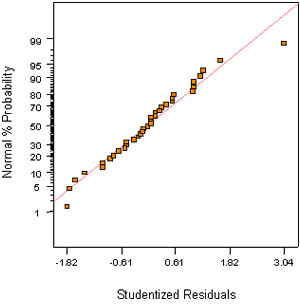
Figure A-1. Mixture experiment: normal probability plot for slump
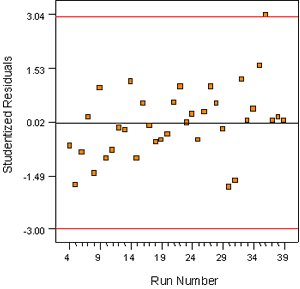
Figure A-2. Mixture experiment: residuals vs. run for slump
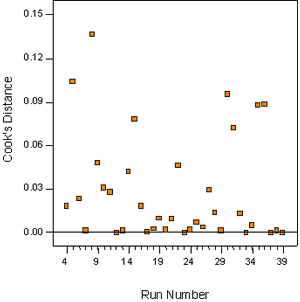
Figure A-3. Mixture experiment: Cook's distance for slump
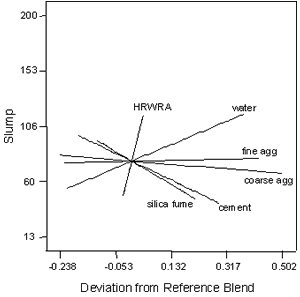
Figure A-4. Mixture experiment: trace plot for slump
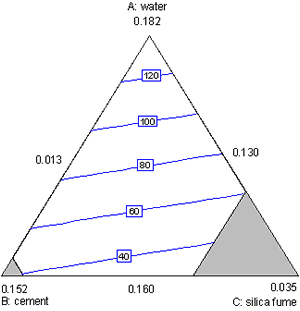
Figure A-5. Mixture experiment: contour plot for slump in water, cement, and silica fume
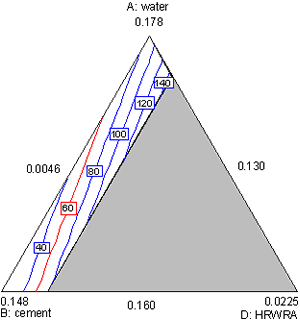
Figure A-6. Mixture experiment: contour plot of slump in water, cement, and HRWRA
Table A-10. Mixture experiment: sequential model sum of squares for 1-day strength
| Source | Sum of Squares | DF | Mean Square | F Value | Prob > F |
|---|---|---|---|---|---|
| Mean | 19278.40 | 1 | 19278.40 | - | - |
| Linear | 351.33 | 5 | 70.27 | 57.34 | < 0.0001 |
| Quadratic | 27.14 | 15 | 1.81 | 2.82 | 0.0266 |
| Special cubic (aliased) | 3.43 | 7 | 0.49 | 0.63 | 0.7199 |
| Cubic (aliased) | 0.00 | 0 | - | - | - |
| Residual | 6.19 | 8 | 0.77 | - | - |
| Total | 19666.48 | 36 | 546.29 | - | - |
Table A-11. Mixture experiment: lack-of-fit test for 1-day strength
| Source | Sum of Squares | DF | Mean Square | F Value | Prob > F |
|---|---|---|---|---|---|
| Linear | 30.57 | 22 | 1.39 | 1.79 | 0.1992 |
| Quadratic | 3.43 | 7 | 0.49 | 0.63 | 0.7199 |
| Special cubic (aliased) | 0.000 | 0 | - | - | - |
| Cubic (aliased) | 0.000 | 0 | - | - | - |
| Pure error | 6.19 | 8 | 0.77 | - | - |
Table A-12. Mixture experiment: summary statistics for 1-day strength
| Source | Std. Dev. | r2 | Adj. r2 | Pred. r2 | PRESS |
|---|---|---|---|---|---|
| Linear | 1.11 | 0.9053 | 0.8895 | 0.8611 | 53.89 |
| Quadratic | 0.80 | 0.9752 | 0.9421 | 0.8566 | 55.65 |
| Special cubic (aliased) | 0.88 | 0.9840 | 0.9302 | - | undefined |
| Cubic (aliased) | - | - | - | - | undefined |
Table A-13. Mixture experiment: ANOVA for 1-day strength mixture model
| Source | Sum of Squares | DF | Mean Square | F Value | Prob > F |
|---|---|---|---|---|---|
| Model | 373.09 | 9 | 41.45 | 71.84 | < 0.0001 |
| Linear mixture | 351.77 | 5 | 70.35 | 121.93 | < 0.0001 |
| AF | 4.14 | 1 | 4.14 | 7.18 | 0.0126 |
| BF | 5.38 | 1 | 5.38 | 9.32 | 0.0052 |
| CD | 3.96 | 1 | 3.96 | 6.86 | 0.0145 |
| DF | 7.83 | 1 | 7.83 | 13.58 | 0.0011 |
| Residual | 15.00 | 26 | 0.58 | - | - |
| Lack of fit | 8.81 | 18 | 0.49 | 0.63 | 0.8010 |
| Pure error | 6.19 | 8 | 0.77 | - | - |
| Corrected total | 388.09 | 35 | - | - | - |
Table A-14. Mixture experiment: coefficient estimates for 1-day strength mixture model
| Component | Coeff. Estimate | DF | Std. Error | 95% CI Low | 95% CI High |
|---|---|---|---|---|---|
| water | 12.93 | 1 | 0.62 | 11.64 | 14.21 |
| Cement | 35.42 | 1 | 0.83 | 33.72 | 37.12 |
| Silica fume | 24.89 | 1 | 1.15 | 22.52 | 27.25 |
| HRWRA | 10.83 | 1 | 8.88 | -7.42 | 29.07 |
| Coarse aaggregate | 22.04 | 1 | 0.43 | 21.16 | 22.93 |
| Fine aaggregate | 21.50 | 1 | 0.57 | 20.32 | 22.67 |
| Water-fine aaggregate | 7.58 | 1 | 2.83 | 1.77 | 13.39 |
| Cement-fine aaggregate | -10.07 | 1 | 3.30 | -16.86 | -3.29 |
| Silica fume-HRWRA | 78.71 | 1 | 30.04 | 16.95 | 140.47 |
| HRWRA-fine aaggregate | 80.50 | 1 | 21.85 | 35.60 | 125.41 |
Model equation in terms of pseudocomponents:
Slump = 12.93*A + 35.42*B + 24.89*C + 10.83*D + 22.04*E + 21.50*F + 7.58* A*F - 10.07*B*F + 78.71*C*D + 80.50*D*F
Model equation in terms of real components:
| Slump = | -1209.1*water + 1775.9*cement - 74.71*SF - 11969*HRWRA |
| + 59.59*Coarse agg - 105.24*Fine agg + 4214.9*water*Fine agg | |
| - 5603.1*cement*Fine agg + 43782 *SF*HRWRA + 44781*HRWRA*Fine agg |
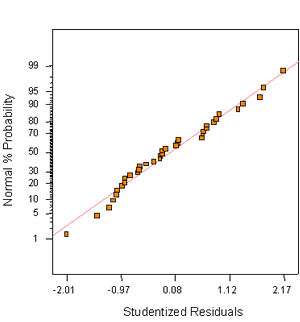
Figure A-7. Mixture experiment: normal probability plot for 1-day strength
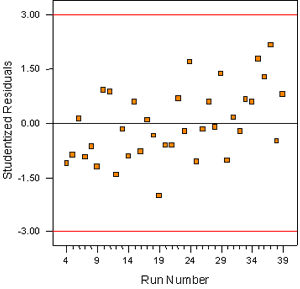
Figure A-8. Mixture experiment: residuals vs. run for 1-day strength
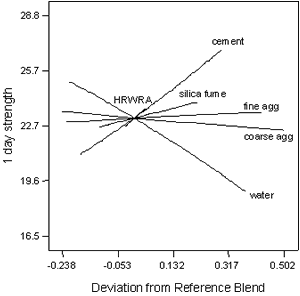
Figure A-9. Mixture experiment: trace plot for 1-day strength
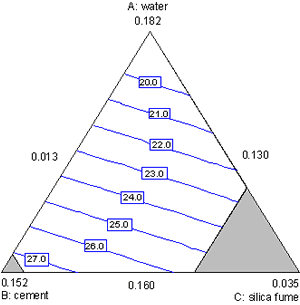
Figure A-10. Mixture experiment: contour plot of 1-day strength in water, cement, and silica fume
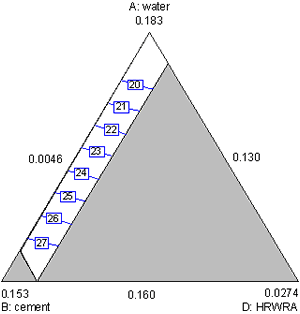
Figure A-11. Mixture experiment: contour plot of 1-day strength in water, cement, and HRWRA
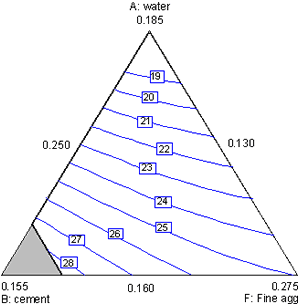
Figure A-12. Mixture experiment: contour plot of 1-day strength in water, cement, and fine aaggregate
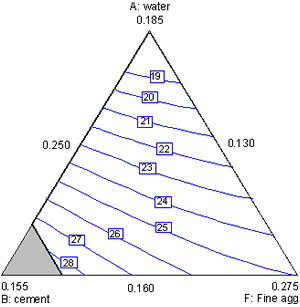
Figure A-13. Mixture experiment: contour plot of 1-day strength in silica fume, HRWRA, and fine aaggregate
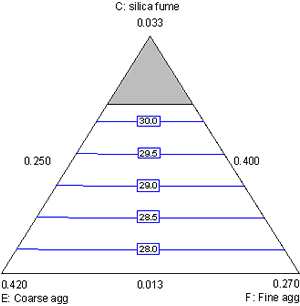
Figure A-14. Mixture experiment: contour plot of 1-day strength in silica fume, coarse aaggregate, and fine aaggregate
Table A-15. Mixture experiment: sequential model sum of squares for 28-day strength
| Source | Sum of Squares | DF | Mean Square | F Value | Prob > F |
|---|---|---|---|---|---|
| Mean | 106213.0 | 1 | 106213.0 | - | - |
| Linear | 257.52 | 5 | 51.50 | 5.46 | 0.0011 |
| Quadratic | 135.19 | 15 | 9.01 | 0.92 | 0.5665 |
| Special cubic (aliased) | 55.45 | 7 | 7.92 | 0.69 | 0.6826 |
| Cubic (aliased) | 0.00 | 0 | - | - | - |
| Residual | 92.17 | 8 | 11.52 | - | - |
| Total | 106753.3 | 36 | 2965.37 | - | - |
Table A-16. Mixture experiment: lack-of-fit test for 28-day strength
| Source | Sum of Squares | DF | Mean Square | F Value | Prob > F |
|---|---|---|---|---|---|
| Linear | 190.64 | 22 | 8.67 | 0.75 | 0.7193 |
| Quadratic | 55.45 | 7 | 7.92 | 0.69 | 0.6826 |
| Special cubic (aliased) | 0.00 | 0 | - | - | - |
| Cubic (aliased) | 0.00 | 0 | - | - | - |
| Pure error | 92.17 | 8 | 11.52 | - | - |
Table A-17. Mixture experiment: model summary statistics for 28-day strength
| Source | Std. Dev. | r2 | Adj. r2 | Pred. r2 | PRESS |
|---|---|---|---|---|---|
| Linear | 3.07 | 0.4755 | 0.3894 | 0.2678 | 395.63 |
| Quadratic | 3.14 | 0.7268 | 0.3625 | -1.5516 | 1378.72 |
| Special cubic (aliased) | 3.39 | 0.8294 | 0.2537 | - | undefined |
| Cubic (aliased) | - | - | - | - | undefined |
Table A-18. Mixture experiment: ANOVA for 28-day strength mixture model
| Source | Sum of Squares | DF | Mean Square | F Value | Prob > F |
|---|---|---|---|---|---|
| Model | 257.52 | 5 | 51.50 | 5.46 | 0.0011 |
| Linear mixture | 257.52 | 5 | 51.50 | 5.46 | 0.0011 |
| Residual | 282.81 | 30 | 9.43 | - | - |
| Lack of fit | 190.64 | 22 | 8.67 | 0.75 | 0.7193 |
| Pure error | 92.17 | 8 | 11.52 | - | - |
| Corrected total | 540.33 | 35 | - | - | - |
Table A-19. Mixture experiment: estimated coefficients for 28-day strength mixture model
| Component | Coeff. Estimate | DF | Std. Error | 95% CI Low | 95% CI High |
|---|---|---|---|---|---|
| Water | 48.60 | 1 | 1.88 | 44.77 | 52.43 |
| Cement | 54.30 | 1 | 2.47 | 49.25 | 59.35 |
| Silica fume | 50.36 | 1 | 3.33 | 43.56 | 57.15 |
| HRWRA | 134.13 | 1 | 18.55 | 96.24 | 172.01 |
| Coarse aaggregate | 52.14 | 1 | 1.64 | 48.79 | 55.50 |
| Fine aaggregate | 54.21 | 1 | 1.72 | 50.70 | 57.73 |
Table A-20. Mixture experiment: adjusted effects for 28-day strength mixture model
| Component | Adjusted Effect | DF | Std. Error | Approx. t for Ho Effect = 0 | Prob > t |
|---|---|---|---|---|---|
| Water | -12.04 | 1 | 2.40 | -5.01 | < 0.0001 |
| Cement | -6.41 | 1 | 2.31 | -2.78 | 0.0093 |
| Silica fume | -6.05 | 1 | 1.93 | -3.13 | 0.0039 |
| HRWRA | 5.43 | 1 | 1.27 | 4.28 | 0.0002 |
| Coarse aaggregate | -16.17 | 1 | 3.84 | -4.22 | 0.0002 |
| Fine aaggregate | -13.69 | 1 | 4.08 | -3.35 | 0.0022 |
Model equation in terms of pseudocomponents:
28-Day Strength = 48.60*A + 54.30*B + 50.36*C + 134.13*D + 52.14*E + 54.21*F
Model equation in terms of real components:
28-Day Strength = -45.22*water + 89.15*cement - 3.809*silica fume + 1972*HRWRA + 38.36*Coarse agg + 87.19*Fine agg
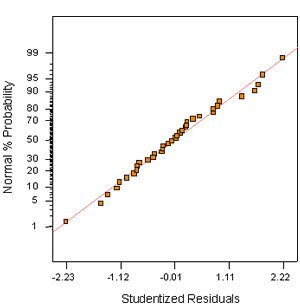
Figure A-15. Mixture experiment: normal probability plot for 28-day strength
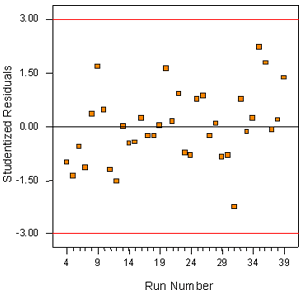
Figure A-16. Mixture experiment: residuals vs. run for 28-day strength
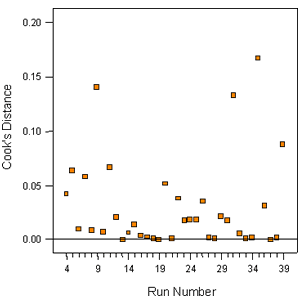
Figure A-17. Mixture experiment: Cook's distance vs. run for 28-day strength
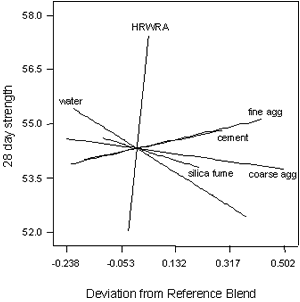
Figure A-18. Mixture experiment: trace plot for 28-day strength
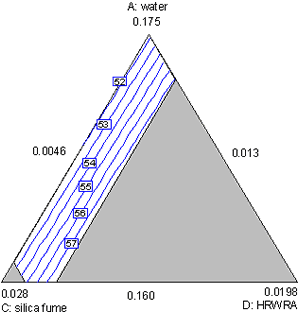
Figure A-19. Mixture experiment: contour plot of 28-day strength in water, silica fume, and HRWRA
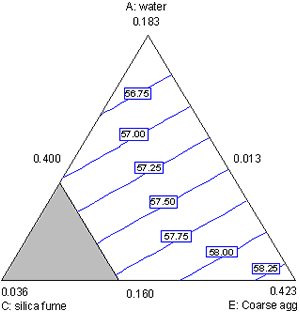
Figure A-20. Mixture experiment: contour plot of 28-day strength in water, silica fume, and coarse aaggregate
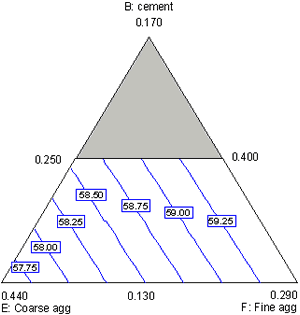
Figure A-21. Mixture experiment: contour plot of 28-day strength in cement, coarse aaggregate, and fine aggregate
Table A-21. Mixture experiment: sequential model sum of squares for RCT charge passed
| Source | Sum of Squares | DF | Mean Square | F Value | Prob > F |
|---|---|---|---|---|---|
| Mean | 1441.26 | 1 | 1441.26 | - | - |
| Linear | 6.75 | 5 | 1.35 | 57.33 | < 0.0001 |
| Quadratic | 0.38 | 15 | 0.03 | 1.17 | 0.3846 |
| Special cubic (aliased) | 0.11 | 7 | 0.02 | 0.57 | 0.7607 |
| Cubic (aliased) | 0.00 | 0 | - | - | - |
| Residual | 0.22 | 8 | 0.03 | - | - |
| Total | 1448.72 | 36 | 40.24 | - | - |
Table A-22. Mixture experiment: lack-of-fit test for RCT charge passed
| Source | Sum of Squares | DF | Mean Square | F Value | Prob > F |
|---|---|---|---|---|---|
| Linear | 0.490 | 22 | 0.022 | 0.82 | 0.6666 |
| Quadratic | 0.109 | 7 | 0.016 | 0.57 | 0.7607 |
| Special cubic (aliased) | 0.000 | 0 | - | - | - |
| Cubic (aliased) | 0.000 | 0 | - | - | - |
| Pure error | 0.217 | 8 | 0.027 | - | - |
Table A-23. Mixture experiment: model summary statistics for RCT charge passed
| Source | Std. Dev. | r2 | Adj. r2 | Pred. r2 | PRESS |
|---|---|---|---|---|---|
| Linear | 0.15 | 0.9053 | 0.8895 | 0.8647 | 1.01 |
| Quadratic | 0.15 | 0.9563 | 0.8980 | 0.8044 | 1.46 |
| Special cubic (aliased) | 0.16 | 0.9709 | 0.8726 | - | undefined |
| Cubic (aliased) | - | - | - | - | undefined |
Table A-24. Mixture experiment: ANOVA for RCT charge passed mixture model
| Source | Sum of Squares | DF | Mean Square | F Value | Prob > F |
|---|---|---|---|---|---|
| Model | 6.75 | 5 | 1.35 | 57.33 | < 0.0001 |
| Linear mixture | 6.75 | 5 | 1.35 | 57.33 | < 0.0001 |
| Residual | 0.71 | 30 | 0.024 | - | - |
| Lack of fit | 0.49 | 22 | 0.022 | 0.82 | 0.6666 |
| Pure error | 0.22 | 8 | 0.027 | - | - |
| Corrected total | 7.46 | 35 | - | - | - |
Table A-25. Mixture experiment: estimated coefficients for RCT charge passed mixture model
| Component | Coeff. Estimate | DF | Std. Error | 95% CI Low | 95% CI High |
|---|---|---|---|---|---|
| Water | 7.2 | 1 | 0.094 | 7.01 | 7.39 |
| Cement | 6.34 | 1 | 0.12 | 6.09 | 6.60 |
| Silica fume | 4.10 | 1 | 0.17 | 3.76 | 4.44 |
| HRWRA | 5.32 | 1 | 0.93 | 3.43 | 7.22 |
| Coarse aaggregate | 6.62 | 1 | 0.082 | 6.46 | 6.79 |
| Fine aaggregate | 6.45 | 1 | 0.086 | 6.28 | 6.63 |
Table A-26. Mixture experiment: adjusted effects for RCT charge passed mixture model
| Component | Adjusted Effect | DF | Std. Error | Approx. t for Ho Effect = 0 | Prob > t |
|---|---|---|---|---|---|
| Water | 0.84 | 1 | 0.12 | 7.03 | < 0.0001 |
| Cement | 0.19 | 1 | 0.12 | 1.65 | 0.1087 |
| Silica fume | -0.76 | 1 | 0.097 | -7.83 | < 0.0001 |
| HRWRA | -0.054 | 1 | 0.063 | -0.85 | 0.3999 |
| Coarse aaggregate | 0.74 | 1 | 0.19 | 3.86 | 0.0006 |
| Fine aaggregate | 0.53 | 1 | 0.20 | 2.62 | 0.0138 |
Model equation in terms of pseudocomponents:
ln(RCT charge passed) = 7.20*A + 6.34*B + 4.10*C + 5.32*D + 6.62*E + 6.45*F
Model equation in terms of real components:
ln(RCT charge passed) = 20.82*water + 0.629*cement - 52.33*silica fume - 23.41*HRWRA + 7.235*Coarse agg + 3.190*Fine agg
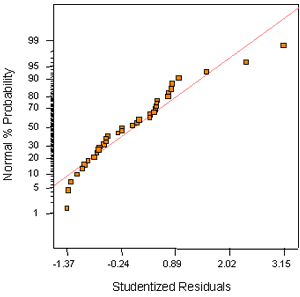
Figure A-22. Mixture experiment: normal probability plot for RCT charge passed (no transform)
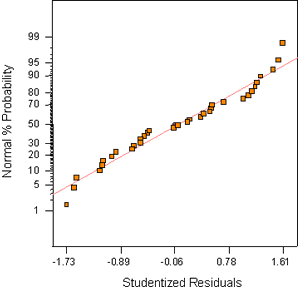
Figure A-23. Mixture experiment: normal probability plot for RCT charge passed (natural log transform)
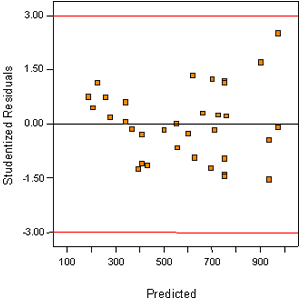
Figure A-24. Mixture experiment: residuals vs. predicted for RCT charge passed (no transform)
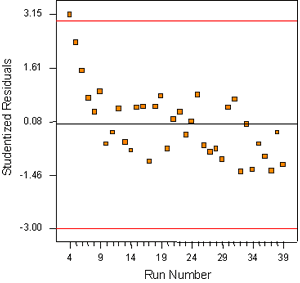
Figure A-25. Mixture experiment: residuals vs. run for RCT charge passed (no transform)
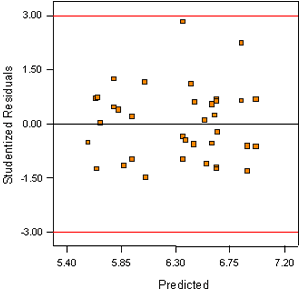
Figure A-26. Mixture experiment: residuals vs. predicted for RCT charge passed (natural log transform)
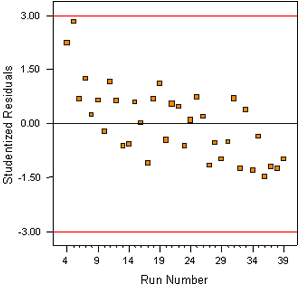
Figure A-27. Mixture experiment: residuals vs. run for RCT charge passed (natural log transform)
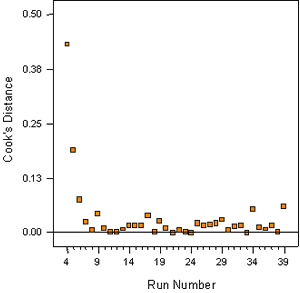
Figure A-28. Mixture experiment: Cook's distance for RCT charge passed (natural log transform)
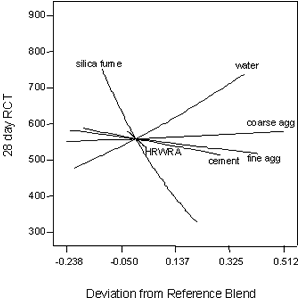
Figure A-29. Mixture experiment: trace plot for RCT charge passed (natural log transform)
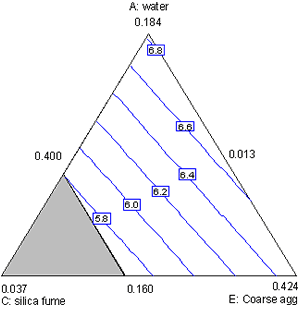
Figure A-30. Mixture experiment: contour plot of ln (RCT charge passed) in water, silica fume, and coarse aaggregate
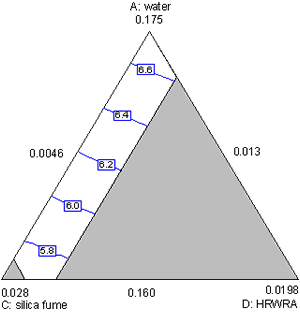
Figure A-31. Mixture experiment: contour plot of ln (RCT charge passed) in water, silica fume, and HRWRA
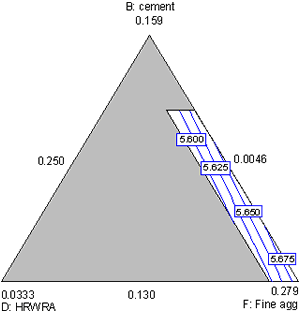
Figure A-32. Mixture experiment: contour plot of ln (RCT charge passed) in cement, HRWRA, and fine aaggregate